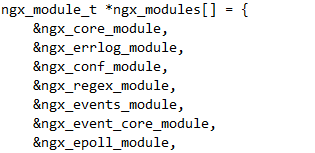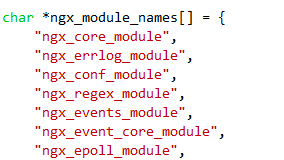Nginx模块解析初识
源码之前,了无秘密!
一、知其然
开发一个Nginx模块,将自己的HTTP模块编译进Nginx
三步走:
1.编写实际开发的xxx.c文件
2.编写的xxx.c文件目录下编写shell脚本的config文件,开发一个HTTP模块,config文件中必要的3个变量如下:
ngx_addon_name:模块名称,只在configure执行时使用
HTTP_MODULES:保存所有的HTTP模块名称,变量的赋值定义方式--->var = "var xxx_module" 例如 HTTP_MODULES="HTTP_MODULES ndg_test_module" 相当于把新的字符串加到变量末尾,类似于“+=”操作符
NDG_ADDON_SRCS:指定模块的源代码
3.编译命令 ./configure --add-module=$your_module_addr
代码来自《Nginx完全开发指南》---罗剑锋
NdgTestModule.cpp
配置的数据结构
struct NdgTestConf final { ngx_flag_t enabled = NgxUnsetValue::get(); //ngx_flag_t类型 将配置文件nginx.conf中的location中的on|off信息转换成1|0 };
配置的解析
static ngx_command_t ndg_test_cmds[] = //配置指令数组 { { ngx_string("ndg_test"), //指令的名字 NGX_HTTP_LOC_CONF|NGX_CONF_FLAG, //指令的作用域和类型 ngx_conf_set_flag_slot, //解析函数指针 NGX_HTTP_LOC_CONF_OFFSET, //数据的存储位置 offsetof(NdgTestConf, enabled), nullptr }, ngx_null_command //空对象,数组结束 };
创建配置数据
static void* create(ngx_conf_t* cf) { return NgxPool(cf).alloc<NdgTestConf>(); }
处理函数
static ngx_int_t handler(ngx_http_request_t *r) { auto cf = reinterpret_cast<NdgTestConf*>( ngx_http_get_module_loc_conf(r, ndg_test_module)); NgxLogError(r).print("hello c++"); if (cf->enabled) { std::cout << "hello nginx" << std::endl; } else { std::cout << "hello disabled" << std::endl; } return NGX_DECLINED; }
注册处理函数(init)
static ngx_int_t init(ngx_conf_t* cf) { auto cmcf = reinterpret_cast<ngx_http_core_main_conf_t*>( ngx_http_conf_get_module_main_conf(cf, ngx_http_core_module)); NgxArray<ngx_http_handler_pt> arr( cmcf->phases[NGX_HTTP_REWRITE_PHASE].handlers); arr.push(handler); return NGX_OK; }
集成配置函数(ngx_http_module_t)
static ngx_http_module_t ndg_test_ctx = { nullptr, init, nullptr, nullptr, nullptr, nullptr, create, nullptr, };
集成配置指令(ngx_module_t)
ngx_module_t ndg_test_module = { NGX_MODULE_V1, // 标准的填充宏 &ndg_test_ctx, // 配置功能函数 ndg_test_cmds, // 配置指令数组 NGX_HTTP_MODULE, // type nullptr, // init master nullptr, // init module nullptr, // init process nullptr, // init thread nullptr, // exit thread nullptr, // exit process nullptr, // exit master NGX_MODULE_V1_PADDING // 标准的填充宏 };
config示例
ngx_addon_name=ndg_test_module ngx_module_type=HTTP ngx_module_name=ndg_test_module ngx_module_srcs="$ngx_addon_dir/NdgTestModule.cpp" HTTP_MODULES="$HTTP_MODULES ndg_test_module" NGX_ADDON_SRCS="$NGX_ADDON_SRCS $ngx_addon_dir/NdgTestModule.cpp"
二、所以然
先认识几个模块的结构
typedef struct ngx_module_s ngx_module_t;
struct ngx_module_s { ngx_uint_t ctx_index; //type类模块数组里的序号(二级索引) ngx_uint_t index; //所有模块数组里的序号(一级索引) char *name; //模块的名字 ngx_uint_t spare0; //保留字段 ngx_uint_t spare1; ngx_uint_t version; //模块版本,值为nginx_version const char *signature; //模块签名,特征码 void *ctx; //函数指针表 ngx_command_t *commands; //模块指令数组 ngx_uint_t type; //模块类型标记 ngx_int_t (*init_master)(ngx_log_t *log); //进程、线程初始化和退出时的回调函数指针(7个) ngx_int_t (*init_module)(ngx_cycle_t *cycle); ngx_int_t (*init_process)(ngx_cycle_t *cycle); ngx_int_t (*init_thread)(ngx_cycle_t *cycle); void (*exit_thread)(ngx_cycle_t *cycle); void (*exit_process)(ngx_cycle_t *cycle); void (*exit_master)(ngx_cycle_t *cycle); uintptr_t spare_hook0; //保留字段(8个) uintptr_t spare_hook1; uintptr_t spare_hook2; uintptr_t spare_hook3; uintptr_t spare_hook4; uintptr_t spare_hook5; uintptr_t spare_hook6; uintptr_t spare_hook7; };
Nginx中的填充宏使上述定义简化为
struct ngx_module_s { NGX_MODULE_V1,void *ctx; ngx_command_t *commands; ngx_uint_t type; NULL, ...(共7个NULL),
NGX_MODULE_V1_PADDING };
ctx是函数指针表,类似C++虚继承里面的虚函数表,Nginx的6类模块定义了自己的ctx结构,命名为ngx_xxx_module_t
typedef struct { ngx_str_t name; void *(*create_conf)(ngx_cycle_t *cycle); char *(*init_conf)(ngx_cycle_t *cycle, void *conf); } ngx_core_module_t;
typedef struct { ngx_str_t name; void *(*create_conf)(ngx_cycle_t *cycle); char *(*init_conf)(ngx_cycle_t *cycle, void *conf); } ngx_core_module_t;
typedef struct { ngx_int_t (*preconfiguration)(ngx_conf_t *cf); ngx_int_t (*postconfiguration)(ngx_conf_t *cf); void *(*create_main_conf)(ngx_conf_t *cf); char *(*init_main_conf)(ngx_conf_t *cf, void *conf); void *(*create_srv_conf)(ngx_conf_t *cf); char *(*merge_srv_conf)(ngx_conf_t *cf, void *prev, void *conf); void *(*create_loc_conf)(ngx_conf_t *cf); char *(*merge_loc_conf)(ngx_conf_t *cf, void *prev, void *conf); } ngx_http_module_t;
typedef struct { void **main_conf; void **srv_conf; void **loc_conf; } ngx_http_conf_ctx_t;
typedef struct ngx_command_s ngx_command_t; struct ngx_command_s { ngx_str_t name; //指令的名字 ngx_uint_t type; //指令的作用域和类型 char *(*set)(ngx_conf_t *cf, ngx_command_t *cmd, void *conf); //指令解析函数 ngx_uint_t conf; //配置结构所在的存储位置 ngx_uint_t offset; //具体的存储变量的偏移量 void *post; };
上面单独把一些结构拎出来,接下来以ngx_core_module为引粗浅介绍模块的配置解析
ngx_module_t定义了很多Nginx框架在加载模块时所必需的信息,可以在编译生成的objs/ngx_modules.c文件种看到所加载的模块信息
部分截图如下:

后面会对应模块的名字:

在nginx.c文件(main函数也在nginx.c)中
ngx_module_t ngx_core_module = { NGX_MODULE_V1, &ngx_core_module_ctx, /* module context */ ngx_core_commands, /* module directives */ NGX_CORE_MODULE, /* module type */ NULL, /* init master */ NULL, /* init module */ NULL, /* init process */ NULL, /* init thread */ NULL, /* exit thread */ NULL, /* exit process */ NULL, /* exit master */ NGX_MODULE_V1_PADDING };
对着上文提到的ngx_module_t的结构来看会比较清晰,NGX_MODULE_V1和NGX_MODULE_V1_PADDING是标准版填充宏。初始化ngx_core_module时调用ngx_core_module_ctx(void* 函数指针有点c++中的泛型和虚函数表的意思),接着调用ngx_core_commands指令数组,NGX_CORE_MODULE是类型标记的type。
Nginx的6类模块(core,conf,event,stream,http,mail)定义了自己ctx结构(函数指针表),命令规范为ngx_xxx_module_t
static ngx_core_module_t ngx_core_module_ctx = { ngx_string("core"), //模块名字 ngx_core_module_create_conf, ngx_core_module_init_conf };
类比于第一部分中的ngx_http_module_t结构,模块的ctx函数指针表,接下来看core模块的create分配内存创建配置数据结构
static void * ngx_core_module_create_conf(ngx_cycle_t *cycle) { ngx_core_conf_t *ccf; //配置结构的数据指针 ccf = ngx_pcalloc(cycle->pool, sizeof(ngx_core_conf_t)); //创建配置数据结构 if (ccf == NULL) { return NULL; } /* * set by ngx_pcalloc() * * ccf->pid = NULL; * ccf->oldpid = NULL; * ccf->priority = 0; * ccf->cpu_affinity_auto = 0; * ccf->cpu_affinity_n = 0; * ccf->cpu_affinity = NULL; */ ccf->daemon = NGX_CONF_UNSET; //值都置为UNSET ccf->master = NGX_CONF_UNSET; ccf->timer_resolution = NGX_CONF_UNSET_MSEC; ccf->shutdown_timeout = NGX_CONF_UNSET_MSEC; ccf->worker_processes = NGX_CONF_UNSET; ccf->debug_points = NGX_CONF_UNSET; ccf->rlimit_nofile = NGX_CONF_UNSET; ccf->rlimit_core = NGX_CONF_UNSET; ccf->user = (ngx_uid_t) NGX_CONF_UNSET_UINT; ccf->group = (ngx_gid_t) NGX_CONF_UNSET_UINT; if (ngx_array_init(&ccf->env, cycle->pool, 1, sizeof(ngx_str_t)) != NGX_OK) { return NULL; } return ccf; }
以上这一步类比于第一部分的create函数。
ngx_core_conf_t是core模块需要配置的数据结构,保存了Nginx运行所需的基本参数,结构如下:
typedef struct { ngx_flag_t daemon; //守护进程标志位 ngx_flag_t master; //master进程标志位 ngx_msec_t timer_resolution; ngx_msec_t shutdown_timeout; ngx_int_t worker_processes; ngx_int_t debug_points; ngx_int_t rlimit_nofile; off_t rlimit_core; int priority; ngx_uint_t cpu_affinity_auto; ngx_uint_t cpu_affinity_n; ngx_cpuset_t *cpu_affinity; char *username; ngx_uid_t user; ngx_gid_t group; ngx_str_t working_directory; ngx_str_t lock_file; ngx_str_t pid; ngx_str_t oldpid; ngx_array_t env; char **environment; ngx_uint_t transparent; /* unsigned transparent:1; */ } ngx_core_conf_t;
创建好了ngx_core_conf_t数据结构,接下来是ngx_core_module_init_conf函数初始化配置结构
static char * ngx_core_module_init_conf(ngx_cycle_t *cycle, void *conf) { ngx_core_conf_t *ccf = conf; ngx_conf_init_value(ccf->daemon, 1); //默认启用守护进程,#define ngx_conf_init_value Nginx以宏的形式提供初始化和条件赋值 ngx_conf_init_value(ccf->master, 1); ngx_conf_init_msec_value(ccf->timer_resolution, 0); ngx_conf_init_msec_value(ccf->shutdown_timeout, 0); ngx_conf_init_value(ccf->worker_processes, 1); ngx_conf_init_value(ccf->debug_points, 0); #if (NGX_HAVE_CPU_AFFINITY) if (!ccf->cpu_affinity_auto && ccf->cpu_affinity_n && ccf->cpu_affinity_n != 1 && ccf->cpu_affinity_n != (ngx_uint_t) ccf->worker_processes) { ngx_log_error(NGX_LOG_WARN, cycle->log, 0, "the number of \"worker_processes\" is not equal to " "the number of \"worker_cpu_affinity\" masks, " "using last mask for remaining worker processes"); } #endif if (ccf->pid.len == 0) { ngx_str_set(&ccf->pid, NGX_PID_PATH); } if (ngx_conf_full_name(cycle, &ccf->pid, 0) != NGX_OK) { return NGX_CONF_ERROR; } ccf->oldpid.len = ccf->pid.len + sizeof(NGX_OLDPID_EXT); ccf->oldpid.data = ngx_pnalloc(cycle->pool, ccf->oldpid.len); if (ccf->oldpid.data == NULL) { return NGX_CONF_ERROR; } ngx_memcpy(ngx_cpymem(ccf->oldpid.data, ccf->pid.data, ccf->pid.len), NGX_OLDPID_EXT, sizeof(NGX_OLDPID_EXT)); #if !(NGX_WIN32) if (ccf->user == (uid_t) NGX_CONF_UNSET_UINT && geteuid() == 0) { struct group *grp; struct passwd *pwd; ngx_set_errno(0); pwd = getpwnam(NGX_USER); if (pwd == NULL) { ngx_log_error(NGX_LOG_EMERG, cycle->log, ngx_errno, "getpwnam(\"" NGX_USER "\") failed"); return NGX_CONF_ERROR; } ccf->username = NGX_USER; ccf->user = pwd->pw_uid; ngx_set_errno(0); grp = getgrnam(NGX_GROUP); if (grp == NULL) { ngx_log_error(NGX_LOG_EMERG, cycle->log, ngx_errno, "getgrnam(\"" NGX_GROUP "\") failed"); return NGX_CONF_ERROR; } ccf->group = grp->gr_gid; } if (ccf->lock_file.len == 0) { ngx_str_set(&ccf->lock_file, NGX_LOCK_PATH); } if (ngx_conf_full_name(cycle, &ccf->lock_file, 0) != NGX_OK) { return NGX_CONF_ERROR; } { ngx_str_t lock_file; lock_file = cycle->old_cycle->lock_file; if (lock_file.len) { lock_file.len--; if (ccf->lock_file.len != lock_file.len || ngx_strncmp(ccf->lock_file.data, lock_file.data, lock_file.len) != 0) { ngx_log_error(NGX_LOG_EMERG, cycle->log, 0, "\"lock_file\" could not be changed, ignored"); } cycle->lock_file.len = lock_file.len + 1; lock_file.len += sizeof(".accept"); cycle->lock_file.data = ngx_pstrdup(cycle->pool, &lock_file); if (cycle->lock_file.data == NULL) { return NGX_CONF_ERROR; } } else { cycle->lock_file.len = ccf->lock_file.len + 1; cycle->lock_file.data = ngx_pnalloc(cycle->pool, ccf->lock_file.len + sizeof(".accept")); if (cycle->lock_file.data == NULL) { return NGX_CONF_ERROR; } ngx_memcpy(ngx_cpymem(cycle->lock_file.data, ccf->lock_file.data, ccf->lock_file.len), ".accept", sizeof(".accept")); } } #endif return NGX_CONF_OK; }
接下来继续回到ngx_module_t ngx_core_module = {}; 中调用ngx_core_commands指令数组,以ngx_null_command结束数组
static ngx_command_t ngx_core_commands[] = { { ngx_string("daemon"), NGX_MAIN_CONF|NGX_DIRECT_CONF|NGX_CONF_FLAG, ngx_conf_set_flag_slot, 0, offsetof(ngx_core_conf_t, daemon), NULL }, { ngx_string("master_process"), NGX_MAIN_CONF|NGX_DIRECT_CONF|NGX_CONF_FLAG, ngx_conf_set_flag_slot, 0, offsetof(ngx_core_conf_t, master), NULL }, { ngx_string("timer_resolution"), NGX_MAIN_CONF|NGX_DIRECT_CONF|NGX_CONF_TAKE1, ngx_conf_set_msec_slot, 0, offsetof(ngx_core_conf_t, timer_resolution), NULL }, { ngx_string("pid"), NGX_MAIN_CONF|NGX_DIRECT_CONF|NGX_CONF_TAKE1, ngx_conf_set_str_slot, 0, offsetof(ngx_core_conf_t, pid), NULL }, { ngx_string("lock_file"), NGX_MAIN_CONF|NGX_DIRECT_CONF|NGX_CONF_TAKE1, ngx_conf_set_str_slot, 0, offsetof(ngx_core_conf_t, lock_file), NULL }, { ngx_string("worker_processes"), NGX_MAIN_CONF|NGX_DIRECT_CONF|NGX_CONF_TAKE1, ngx_set_worker_processes, 0, 0, NULL }, { ngx_string("debug_points"), NGX_MAIN_CONF|NGX_DIRECT_CONF|NGX_CONF_TAKE1, ngx_conf_set_enum_slot, 0, offsetof(ngx_core_conf_t, debug_points), &ngx_debug_points }, { ngx_string("user"), NGX_MAIN_CONF|NGX_DIRECT_CONF|NGX_CONF_TAKE12, ngx_set_user, 0, 0, NULL }, { ngx_string("worker_priority"), NGX_MAIN_CONF|NGX_DIRECT_CONF|NGX_CONF_TAKE1, ngx_set_priority, 0, 0, NULL }, { ngx_string("worker_cpu_affinity"), NGX_MAIN_CONF|NGX_DIRECT_CONF|NGX_CONF_1MORE, ngx_set_cpu_affinity, 0, 0, NULL }, { ngx_string("worker_rlimit_nofile"), NGX_MAIN_CONF|NGX_DIRECT_CONF|NGX_CONF_TAKE1, ngx_conf_set_num_slot, 0, offsetof(ngx_core_conf_t, rlimit_nofile), NULL }, { ngx_string("worker_rlimit_core"), NGX_MAIN_CONF|NGX_DIRECT_CONF|NGX_CONF_TAKE1, ngx_conf_set_off_slot, 0, offsetof(ngx_core_conf_t, rlimit_core), NULL }, { ngx_string("worker_shutdown_timeout"), NGX_MAIN_CONF|NGX_DIRECT_CONF|NGX_CONF_TAKE1, ngx_conf_set_msec_slot, 0, offsetof(ngx_core_conf_t, shutdown_timeout), NULL }, { ngx_string("working_directory"), NGX_MAIN_CONF|NGX_DIRECT_CONF|NGX_CONF_TAKE1, ngx_conf_set_str_slot, 0, offsetof(ngx_core_conf_t, working_directory), NULL }, { ngx_string("env"), NGX_MAIN_CONF|NGX_DIRECT_CONF|NGX_CONF_TAKE1, ngx_set_env, 0, 0, NULL }, { ngx_string("load_module"), NGX_MAIN_CONF|NGX_DIRECT_CONF|NGX_CONF_TAKE1, ngx_load_module, 0, 0, NULL }, ngx_null_command };
在ngx_core_command[]中,每一个数组元素结构体中有指令的名字,指令的作用域。例如NGX_HTTP_MAIN_CONF表示指令可以出现在配置文件(nginx.conf)的http块里面,NGX_HTTP_LOC_CONF表示可以出现在location块里面。NGX_MAIN_CONF|NGX_DIRECT_CONF表示只能出现在配置文件最外层的main域,不是http main域。根据ngx_command_s结构体里面的conf和offset在配置的数据结构ngx_core_conf_t里找到变量位置,通过ngx_conf_set_flag_slot之类的解析函数来进行指令的解析。以ngx_conf_set_flag_slot为例将 on|off 解析成数字 1|0
char * ngx_conf_set_flag_slot(ngx_conf_t *cf, ngx_command_t *cmd, void *conf) { char *p = conf; ngx_str_t *value; ngx_flag_t *fp; ngx_conf_post_t *post; fp = (ngx_flag_t *) (p + cmd->offset); if (*fp != NGX_CONF_UNSET) { return "is duplicate"; } value = cf->args->elts; if (ngx_strcasecmp(value[1].data, (u_char *) "on") == 0) { *fp = 1; } else if (ngx_strcasecmp(value[1].data, (u_char *) "off") == 0) { *fp = 0; } else { ngx_conf_log_error(NGX_LOG_EMERG, cf, 0, "invalid value \"%s\" in \"%s\" directive, " "it must be \"on\" or \"off\"", value[1].data, cmd->name.data); return NGX_CONF_ERROR; } if (cmd->post) { post = cmd->post; return post->post_handler(cf, post, fp); } return NGX_CONF_OK; }
ngx_core_module本身没有业务逻辑,只是提供了Nginx运行所需的基本参数,由Nginx框架在运行时直接获取和使用。
启动Nginx时,nginx.c文件中的main函数调用ngx_get_conf来从conf_ctx数组里获取配置结构,对于core模块来说就是ngx_core_conf_t
ccf = (ngx_core_conf_t *) ngx_get_conf(cycle->conf_ctx, ngx_core_module);
conf_ctx定义在ngx_cycle_s中 ( typedef struct ngx_cycle_s ngx_cycle_t)
struct ngx_cycle_s { void ****conf_ctx; //配置数据的起始存储位置 ngx_pool_t *pool; ngx_log_t *log; ngx_log_t new_log; ngx_uint_t log_use_stderr; /* unsigned log_use_stderr:1; */ ngx_connection_t **files; ngx_connection_t *free_connections; ngx_uint_t free_connection_n; ngx_module_t **modules; ngx_uint_t modules_n; ngx_uint_t modules_used; /* unsigned modules_used:1; */ ngx_queue_t reusable_connections_queue; ngx_uint_t reusable_connections_n; ngx_array_t listening; ngx_array_t paths; ngx_array_t config_dump; ngx_rbtree_t config_dump_rbtree; ngx_rbtree_node_t config_dump_sentinel; ngx_list_t open_files; ngx_list_t shared_memory; ngx_uint_t connection_n; ngx_uint_t files_n; ngx_connection_t *connections; ngx_event_t *read_events; ngx_event_t *write_events; ngx_cycle_t *old_cycle; ngx_str_t conf_file; ngx_str_t conf_param; ngx_str_t conf_prefix; ngx_str_t prefix; ngx_str_t lock_file; ngx_str_t hostname; };
ngx_get_conf是个函数宏
#define ngx_get_conf(conf_ctx, module) conf_ctx[module.index]
从conf_ctx配置结构数组里获取当前配置的位置,索引是module.index,也就是ngx_module_t结构里的index成员,index标记了模块在modules数组里的索引位置。objs/ngx_modules.c中可以查看这些modules
三、初识结语
反复的层级递归才粗略的摸清其中的结构,革命尚未成功,仍需继续!
参考资料
《Nginx完全开发指南 使用C、C++和OpenResty》---罗剑锋
《深入理解Nginx 模块开发与架构解析 第二版》---陶辉


 浙公网安备 33010602011771号
浙公网安备 33010602011771号